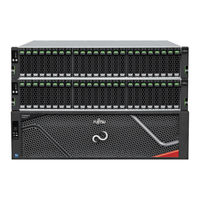Fujitsu ETERNUS DX900 S6 Manuals
Manuals and User Guides for Fujitsu ETERNUS DX900 S6. We have 2 Fujitsu ETERNUS DX900 S6 manuals available for free PDF download: Design Manual, Operation Manual
Fujitsu ETERNUS DX900 S6 Design Manual (243 pages)
Table of Contents
-
Overview18
-
RAID Group27
-
Volume30
-
Hot Spare32
-
Rebuild40
-
Audit Log79
-
Eco-Mode83
-
Host Sense94
-
Backup99
-
Local Copy99
-
Remote Copy102
-
Figure 45 REC114
-
Assigned Cms120
-
Multitenancy132
-
Stable Operation133
-
Figure 72 Qos133
-
Host Response135
-
Storage Cluster136
-
Data Migration141
-
Vmware Linkage145
-
Windows Server154
-
UPS Connection156
-
LAN Connection158
-
SAN Connection167
-
Host Interface167
-
Access Method169
-
Eternus Dx900 S6179
-
Component181
-
Eternus Dx600 S6183
-
Eternus Dx900 S6185
-
Controllers187
-
Component190
-
Drive Enclosure191
-
Component193
-
System Memory200
-
Host Interface203
-
Drive Adapters206
-
Drive Enclosure207
-
Drive208
-
Eternus Dx600 S6222
-
Eternus Dx900 S6223
-
Table 90 Table226
-
Specifications227
-
Supported Oss227
Advertisement
Fujitsu ETERNUS DX900 S6 Operation Manual (40 pages)
Table of Contents
-
Powering on17
-
Powering off21
-
Audit Log28
-
Maintenance32
-
Check List34
Advertisement

